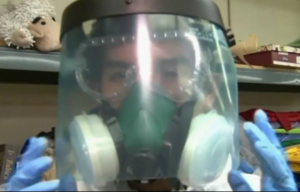 IS IT JUST me, or did everyone’s Halloween party this year include some stupidly grinning neighbor in a hazmat suit costume? Most years, by early October, I’ve girded my emotional loins against the yearly onslaught of sexist and racist costumes. But this year, Halloween revelers seemed to take ‘transgressive’ cultural humor to a new low. Hands down, variations of the ‘Sexy Ebola Nurse’ costume took the viral cake.
IS IT JUST me, or did everyone’s Halloween party this year include some stupidly grinning neighbor in a hazmat suit costume? Most years, by early October, I’ve girded my emotional loins against the yearly onslaught of sexist and racist costumes. But this year, Halloween revelers seemed to take ‘transgressive’ cultural humor to a new low. Hands down, variations of the ‘Sexy Ebola Nurse’ costume took the viral cake.
These atrocious re-appropriations of the hazmat are pretty consistent with the way that Ebola has both horrified and titillated the collective American imagination in the last few months. Everywhere you look these days, you see what might be called Ebola porn – not just Halloween health care workers in gas masks and really short skirts, but those ubiquitous images of the (oddly phallic) virus itself – in electron micrograph after electron micrograph.
 These attempts to trivialize and visualize the threat of Ebola may be a human coping mechanism in the face of fear. We feel a sense of control over that which we can see, or make humorous. Yet, Ebola porn is ultimately about the way that U.S. media outlets have been narrating not just the Ebola virus, but Africa and Africans, in the face of the current epidemic.
These attempts to trivialize and visualize the threat of Ebola may be a human coping mechanism in the face of fear. We feel a sense of control over that which we can see, or make humorous. Yet, Ebola porn is ultimately about the way that U.S. media outlets have been narrating not just the Ebola virus, but Africa and Africans, in the face of the current epidemic.
Consider how many images of Ebola in Africa are akin to ‘poverty porn’ – those gut-wrenching images and films of sad children in far off lands living amid squalor and filth. From Born into Brothels to Slumdog Millionaire, these visual narratives are inevitably what Arthur and Joan Kleinman call “narratives of indigenous absence.” In their co-edited volume Social Suffering, they write,
…images of distant, suffering women and children suggest there are communities incapable of or uninterested in caring for its own people. These photographs justify colonialist, paternalistic attitudes and policies, suggesting that the individual in the photograph…must be protected, as well as represented, by others…Something must be done, and it must be done soon, but from outside the local setting.
~
From this framework, consider one of the images accompanying the October 1st New York Times headline “Hospital from Hell, in a city swamped by Ebola.” The photograph features a young child lying alone on a filthy urine-and- other-body-fluid soaked hospital floor. There are no caregivers, no adults or even other children visible in the image. Even she is tucked into the far lower left corner, desperately staring out at the viewer with a mixture of resignation and exhaustion.
The first time I saw this image, taken by Samuel Aranda, I was reminded of another such photograph of childhood suffering in Africa. Winner of the 1994 Pulitzer Prize for Photography, South African photojournalist Kevin Carter is best known for his prize-winning image of a starved child being watched by a vulture during the famine in Sudan. Both Carter’s photograph and recent images of West African Ebola prompt us to wonder – what are we to do as viewers when we see images of distant, and distanced, suffering? In her classic Regarding the Pain of Others, Susan Sontag cautions against the pornographic lure of suffering-as-spectacle:
Compassion is an unstable emotion. It needs to be translated into action, or it withers. The question of what to do with the feelings that have been aroused, the knowledge that has been communicated. If one feels that there is nothing ‘we’ can do — but who is that ‘we’? — and nothing ‘they’ can do either — and who are ‘they’ — then one starts to get bored, cynical, apathetic.
Such photographs only reinforce the seemingly inevitable nature of suffering in Africa. Carter’s framing of the image – to leave out the close-by food distribution center and other people – leaves the photographic environment utterly natural; there are no other human beings, no buildings, no signs of modern life. There is only the malnourished child, some brush, and the evil-looking bird. Although Aranda’s photo from the hospital in Makeni, Sierra Leone, is set in the man-made structure of the hospital – it is a hospital broken down; where ill children lie on filthy, unhygienic floors and adults are non-entities.
What is the lure of such stories about Africa, stories which suggest an imaginary, monolithic ‘dark continent’ bereft of natural resources, talent, will power, or leadership? In the case of Ebola, such stories somewhat protect the Western consciousness from the risk of infection. After all, this is a disease of poor, downtrodden, resource-poor ‘them,’ not a disease of privileged and powerful ‘us.’
Other narrative pornographies of Ebola tap into an imagined geography defined by bestiality and animalistic practices. The September 29, 2014 Newsweek cover, for instance, features a sad-looking chimpanzee with the words “A Back Door for Ebola” written across its fur in yellow and white. The magazine’s racist and alarmist concern that “Smuggled bushmeat could spark a U.S. epidemic” generated the twitter hastag #newsweekfail, and has been roundly critiqued by many, including a Washington Post blog that argued this fictitious concern is in fact just xenophobic worry about “primitive” African eating habits, and part of “The Long and Ugly Tradition of Treating Africa as a Dirty, Diseased Place.” The placing of the chimpanzee as a literal and figurative stand-in for the face of African Ebola harkens not only to the pseudoscience of phrenology, which likened Africans to monkeys, but also recalls racist and homophobic explanations for the origin of HIV as related somehow to African practices of bestiality, particularly, sex with monkeys. Even the phrase “back door” is a fairly obvious nod to anal sex or other non-heterocentric, ‘unsavory’ sexual practices.
Other magazine covers have gone the way of visually likening Ebola to some sort of zombie apocalypse. (Please do remember that prior to George Romero’s classic 1968 Night of the Living Dead, zombie films were set almost exclusively in Haiti or Africa and featured the dark-skinned undead. Coincidence? Hm.) Bloomberg business week’s bloody-graffiti-like headline “Ebola is coming” was crafted to look like something out of a Walking Dead episode. In fact, there are several episodes of the bloody (dare I say gore-porn?) television show in which characters write billboard-style messages for one another after coating their hands in actual zombie guts and blood. [ZOMBIE FANS – SPOILERS AHEAD!] A recent Walking Dead episode entitled “There is no sanctuary” in fact included a military-engineered-viral-infection explanation for the zombie-apocalypse. It also had a complicated ‘we were raped by those we tried to save’ backstory for a human community called ‘Terminus,’ which now lures unsuspecting fellow zombie-apocalypse survivors into its boundaries in order not to rape, but butcher and (gag) cannibalize them. Bloomberg Business week’s cover image, which came out at the same time that the hit zombie show is running its fifth successful season, clearly taps into these pop-cultural narratives which conflate viral risk, gory death, and sexual violence. More importantly, it taps into the narrative of ‘state’ boundaries breached by ‘Others’ who are at first mistaken as needing of one’s help, but turn out to be bloodthirsty predators of one’s flesh (sexual or otherwise). I can’t help but think that this story line has much in common with the historic association of immigrants and impoverished communities with disease and contagion, as well as tea-party and other rhetoric about ‘stopping Ebola at our borders’ and ‘Ebola terrorism.’ A congressman believing that Hamas might infect themselves with Ebola and “sneak into the U.S.” isn’t that far off from fantasies of the rape-ridden zombie apocalypse.
 Even the much contested quarantine of nurse Kaci Hickox as she recently returned from Sierra Leone can be read against this narrative of ‘Ebola porn.’ It is as if in caring for ‘them’ in Africa, a woman like Kaci Hickox is somehow betraying ‘us,’ and putting the (heteromasculine) nation at risk. (White American nurses are supposed to be selflessly caring for white Americans – particularly white American men and ALL their embodied needs, right?) In fact, the furor around Kaci Hickox reminds me of an iconic WWII public health poster cautioning soldiers to protect themselves against venereal diseases. In the image, the giant head of a mysteriously smiling, white-collared woman – perhaps a nurse – hovers over a sailor, soldier and businessman. Declares the caption: “She may look clean – BUT” and “You can’t beat the axis if you get VD!” Here, the sexual deviances of this maybe-a-nurse woman personifies not only a contagious threat to the corporeal bodies of these men, but the national body politic itself. Someone may look innocent/clean/needing of help but we must be ever vigilant of our personal, communal and national bodies from the threat of foreign assailants – racialized, gendered, viral, human, and nonhuman alike.
Even the much contested quarantine of nurse Kaci Hickox as she recently returned from Sierra Leone can be read against this narrative of ‘Ebola porn.’ It is as if in caring for ‘them’ in Africa, a woman like Kaci Hickox is somehow betraying ‘us,’ and putting the (heteromasculine) nation at risk. (White American nurses are supposed to be selflessly caring for white Americans – particularly white American men and ALL their embodied needs, right?) In fact, the furor around Kaci Hickox reminds me of an iconic WWII public health poster cautioning soldiers to protect themselves against venereal diseases. In the image, the giant head of a mysteriously smiling, white-collared woman – perhaps a nurse – hovers over a sailor, soldier and businessman. Declares the caption: “She may look clean – BUT” and “You can’t beat the axis if you get VD!” Here, the sexual deviances of this maybe-a-nurse woman personifies not only a contagious threat to the corporeal bodies of these men, but the national body politic itself. Someone may look innocent/clean/needing of help but we must be ever vigilant of our personal, communal and national bodies from the threat of foreign assailants – racialized, gendered, viral, human, and nonhuman alike.
In August of this year, extremist Christian radio host Rick Wiles declared that “Ebola could solve America’s problems with atheism, homosexuality, sexual promiscuity, pornography and abortion.” How so? As a plague that would wipe out all the fornicators & etc., naturally. This imagined coupling of Ebola with mostly sexual ‘deviances’ is consistent with the hypersexualization of dark skinned peoples which is so part and parcel of our “Othering.” In addition, it taps into the association of Africa with sex, blood, horror and death. From innocent children to primitive, bestial natives to infecting, border-crossing terrorists, the politics of Ebola porn are ultimately the politics of racism, xenophobia, demonizing, and distancing. Sexy hazmat suits aren’t going to protect us from the visual violence of these viral images; it’s time to find an antidote for this real-life American Horror Story.
*Infinite thanks to my ‘Team Bordaspora” student-colleagues, Margaret Anne Cunney, Kevin Gutierrez, Nakaweesee Katongole, Sasha Kruger and Kimberly LaForce for their assistance in the preparation of these thoughts.



